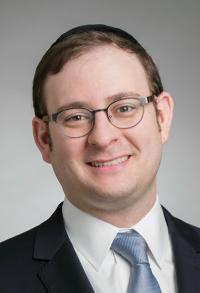Jay Leb, MD, Appointed Director of Cardiac Imaging
The Department of Radiology is pleased to announce Dr. Jay Leb's new appointment as director of cardiac imaging.
Dr. Leb, assistant professor of radiology at Columbia University Irving Medical Center (CUIMC), has been instrumental in solidifying the collaboration between CUIMC's cardiac imagers, cardiologists, and cardiac surgeons, to the benefit of patients. As director, he will oversee cardiac imaging at four CUIMC and NewYork-Presbyterian (NYP) locations.
“I'm excited to continue to grow our cardiothoracic imaging subspecialty," said Dr. Leb. "The department has been very supportive in creating four sites with advanced CT and MRI scanners, which will enable us to provide better imaging for our patients.”
Dr. Leb joined the Department of Radiology in the Division of Cardiothoracic Imaging in 2016. In addition to his clinical responsibilities, he serves as the program director for the Cardiothoracic Imaging Fellowship.
Q & A With Dr. Leb
What's new in cardiac imaging at Columbia?
We recently upgraded to advanced cardiac CT scanners at our main hospital location in Milstein Hospital, as well as at our ColumbiaDoctors Tarrytown and NYP Allen Hospital locations. We are also in the process of upgrading the cardiac CT scanner at NYP Lawrence Hospital. All four sites will have advanced cardiac CT and MRI scanners, which will help us expand our cardiac imaging department.
The new CT scanners have many advantages, including the ability to image the entire heart in one heartbeat. This allows us to better visualize and evaluate the cardiac structures including the heart chambers, valves, and coronary arteries. We are then able to better diagnose pathology, help plan procedures and surgeries, and reevaluate the cardiac structures after these procedures have been performed.
How do you work with cardiology and cardiac surgery at Columbia?
Columbia is world-renowned for cardiology and cardiac surgery. We have one of the leading cardiac surgery programs in the country, including the highly specialized Aortic Center. We also have the Structural Heart and Valve Center, where cutting edge and experimental percutaneous transcatheter valve replacements are performed. In addition, we have a large population of congenital heart patients at our Adult Congenital Heart Center, who require lifetime surveillance and at times, additional surgeries and procedures.
All of these services rely on imaging of the heart. We act as consultants to both obtain the appropriate images and successfully interpret them, in order to guide the management of the patients. For example, for congenital heart patients, we provide critical information to the cardiologists and surgeons which helps them determine when additional surgeries are needed or when it is appropriate to delay further intervention.
In most of radiology, a select set of dedicated protocols are utilized to image a patient, and the radiologist interprets the images after they are acquired. In cardiac imaging, especially at Columbia, we are faced with complex clinical questions, and we tailor each study to the individual patient and review the images in real-time, requesting additional imaging when needed. We are then able to better answer the clinical questions and hopefully avoid the need for additional testing.
Our imaging group is made up of both radiologists and cardiologists who have advanced training in cardiac imaging. Our cardiology colleagues add their clinical perspective to our group which aids in our interpretation of these complex studies. There is excellent collaboration between the radiologists and the referring physicians, and many of the complex cases are reviewed with our cardiologists and surgeons either at the radiology work station, over Zoom, or in our interdisciplinary conferences. We are a cohesive unit, which ultimately benefits our patients.
What are your responsibilities as director of cardiac imaging?
Since the mid 2000's, our cardiac imaging volume in radiology has increased exponentially, with more reliance on cardiac CT and MRI than ever before. When I started in 2016, there was only one other dedicated cardiac radiologist, Dr. Belinda D'Souza, along with our cardiology colleagues, Drs. Andrew Einstein and Todd Pulerwitz. Since that time we have significantly grown the program together as a team, adding to the volume of cases and complexity of imaging.
As director, I will ensure that the imaging runs smoothly and the team continues to work as a cohesive unit together with our clinicians, as well as our technologists, nurses, and schedulers. Now that we have advanced CT at all four sites, along with our advanced MRI scanners, it's important to continue to use our technology to the best of our ability to help our patients.
What drew you to cardiac imaging?
When I started medical school I was considering a career in cardiology, and I was particularly interested in congenital heart disease. In my third year I became increasingly interested in radiology, as imaging is often the key to the diagnosis of many pathologies. Cardiac imaging allows me to fuse the two interests. Figuring out the anatomy and post-surgical changes is complex, challenging, and interesting. I enjoy working together with talented clinicians and radiologists at a world-renowned institution like Columbia University Irving Medical Center.

